Laccase Immobilized Fe3O4-Graphene Oxide Nanobiocatalyst Improves Stability and Immobilization Efficiency in the Green Preparation of Sulfa Drugs
Abstract
1. Introduction
2. Results and Discussions
2.1. Optimum Conditions for the Preparation of Lac/Fe3O4/GO
2.2. Characterization of Lac/Fe3O4/GO
2.3. Investigation of the Activity and Characteristic Properties of Free Laccase and Lac/Fe3O4/GO
2.3.1. Estimation of Kinetic Parameters for the Free Enzyme Laccase and Lac/Fe3O4/GO
2.3.2. Effect of Temperature and pH on the Activity of Free and Immobilized Laccase
2.3.3. Thermal and Storage Stability
2.4. The Catalytic Application of Lac/Fe3O4/GO in the Aerobic Oxidative Coupling of 2,3-Dihydrophthalazine-1,4-dione and Sodium Benzenesulfinates at Mild Conditions
2.5. Reusability of Lac/Fe3O4/GO
3. Methods
3.1. Chemicals
3.2. Preparation of Graphene Oxide
3.3. Preparation of Fe3O4/GO Nanocomposite
3.4. Preparation of NH2/Fe3O4/GO, GA/Fe3O4/GO, and Immobilization of Laccase onto Fe3O4/GO Nanocomposite
3.5. Activity Assay of Free and Immobilized Laccase
3.6. Determination of Kinetic Parameters of Free and Immobilized Laccase
3.7. Effect of Temperature and pH on the Activity of Free and Immobilized Laccase
3.8. Thermal and Storage Stability of Free and Immobilized Laccase
3.9. General Procedure for Synthesis of Sulfonamide Derivatives by Aerobic Oxidative Coupling between 2,3-Dihydrophthalazine-1,4-Dione and Sodium Benzenesulfinates in the Presence of Lac/Fe3O4/GO as a Recoverable Nanobiocatalyst
4. Conclusions
Supplementary Materials
Author Contributions
Funding
Acknowledgments
Conflicts of Interest
References
- Henry, R.J. The Mode of Action of Sulfonamides. Bacteriol. Rev. 1943, 7, 175–262. [Google Scholar] [CrossRef]
- Ganguly, A.K.; Alluri, S.S.; Caroccia, D.; Biswas, D.; Wang, C.H.; Kang, E.; Zhang, Y.; McPhail, A.T.; Carroll, S.S.; Burlein, C.; et al. Design, synthesis, and X-ray crystallographic analysis of a novel class of HIV-1 protease inhibitors. J. Med. Chem. 2011, 54, 7176–7183. [Google Scholar] [CrossRef]
- Msagati, T.A.M.; Nindi, M.M. Multiresidue determination of sulfonamides in a variety of biological matrices by supported liquid membrane with high pressure liquid chromatography-electrospray mass spectrometry detection. Talanta 2004, 64, 87–100. [Google Scholar] [CrossRef]
- Shi, F.M.; Tse, K.X.; Cui, J.; Gördes, D.; Michalik, D.; Thurow, K.; Deng, Y.Q.; Beller, M. Copper-catalyzed alkylation of sulfonamides with alcohols. Angew. Chem. Int. Ed. 2009, 48, 5912–5915. [Google Scholar] [CrossRef] [PubMed]
- Huang, X.; Wang, J.C.; Ni, Z.Q.; Wang, S.C.; Pan, Y.J. Copper-mediated S–N formation via an oxygen-activated radical process: A new synthesis method for sulphonamides. Chem. Commun. 2014, 50, 4582–4584. [Google Scholar] [CrossRef]
- Pan, X.; Gao, J.; Liu, J.; Lai, J.; Jiang, H.; Yuan, G. Synthesis of sulfonamides via I2-mediated reaction of sodium sulfinates with amines in an aqueous medium at room temperature. Green Chem. 2015, 17, 1400–1403. [Google Scholar] [CrossRef]
- Rosen, B.R.; Ruble, J.C.; Beauchamp, T.J.; Navarro, A. Mild Pd-Catalyzed N-Arylation of Methanesulfonamide and Related Nucleophiles: Avoiding Potentially Genotoxic Reagents and Byproducts. Org. Lett. 2011, 13, 2564–2567. [Google Scholar] [CrossRef] [PubMed]
- Tang, X.D.; Huang, L.B.; Qi, C.R.; Wu, X.; Wu, W.Q.; Jiang, H.F. Copper-catalyzed sulfonamides formation from sodium sulfinates and amines. Chem. Commun. 2013, 49, 6102–6104. [Google Scholar] [CrossRef] [PubMed]
- Nematollahi, D.; Hosseiny Davarani, S.S.; Mirahmadpour, P.; Varmaghani, F. A facile electrochemical method for the synthesis of new sulfonamide derivatives of potential biological significance. Chin. Chem. Lett. 2014, 25, 593–595. [Google Scholar] [CrossRef]
- Lund, H.; Hammerich, O. Organic Electrochemistry, 4th ed.; Marcel Dekker Inc.: New York, NY, USA, 2001. [Google Scholar]
- Garcia, J.; Zhang, Y.; Taylor, H.; Cespedes, O.; Webb, M.E.; Zhou, D.J. Multilayer enzyme-coupled magnetic nanoparticles as efficient, reusable biocatalysts and biosensors. Nanoscale 2011, 3, 3721–3730. [Google Scholar] [CrossRef]
- Couto, S.; Toco-Herrera, J.L. Industrial and biotechnological applications of laccases: A review. Biotechnol. Adv. 2006, 24, 500–513. [Google Scholar] [CrossRef]
- Riva, S. Laccases: Blue enzyme for green chemistry. Trends Biotechnol. 2006, 24, 219–226. [Google Scholar] [CrossRef]
- Viswanath, B.; Rajesh, B.; Janardhan, A.; Kumar, A.P.; Narasimha, G. Fungal laccases and their applications in bioremediation. Enzyme Res. 2014, 2014, 1. [Google Scholar] [CrossRef] [PubMed]
- Pezzella, C.; Guarino, L.; Piscitelli, A. How to enjoy laccases. Cell. Mol. Life Sci. 2015, 72, 923–940. [Google Scholar] [CrossRef]
- Kudanga, T.; Roes-Hill, M.L. Laccase applications in biofuels production: Current status and future prospects. Appl. Microbiol. Biotechnol. 2014, 98, 6525–6542. [Google Scholar] [CrossRef] [PubMed]
- Yang, J.; Li, W.; Ng, T.B.; Deng, X.; Lin, J.; Ye, X. Laccases: Production, expression regulation, and applications in pharmaceutical biodegradation. Front. Microbiol. 2017, 8, 832. [Google Scholar] [CrossRef] [PubMed]
- Stanescu, M.D.; Fogorasi, M.; Shaskolskiv, B.L.; Gavrilas, S.; Lozinsky, V.I. New Potential Biocatalysts by Laccase Immobilization in PVA Cryogel Type Carrier. Appl. Biochem. Biotechnol. 2010, 160, 1947–1954. [Google Scholar] [CrossRef]
- Kulys, J.; Vidziunaite, R.; Schneider, P. Laccase-catalyzed oxidation of naphthol in the presence of soluble polymers. Enzyme Microb. Technol. 2003, 32, 455–463. [Google Scholar] [CrossRef]
- Saoudi, O.; Ghaouar, N.; Bensalah, S.; Othman, T. Denaturation process of laccase in various media by refractive index measurements. Biochem. Biophys. Rep. 2017, 11, 19–26. [Google Scholar] [CrossRef]
- Nasoohi, N.; Khajeh, K.; Mohammadian, M.; Ranjbar, B. Enhancement of catalysis and functional expression of a bacterial laccase by single amino acid replacement. Int. J. Biol. Macromol. 2013, 60, 56–61. [Google Scholar] [CrossRef]
- Abejon, R.; Belleville, M.P.; Marcano, J.S. Design, economic evaluation and optimization of enzymatic membrane reactors for antibiotics degradation in wastewaters. Sep. Purif. Technol. 2015, 156, 183–199. [Google Scholar] [CrossRef]
- Tran, D.N.; Balkus, K.J. Perspective of recent progress in immobilization of enzymes. ACS Catal. 2011, 1, 956–968. [Google Scholar] [CrossRef]
- Singh, R.K.; Tiwari, M.K.; Singh, R.; Haw, J.R.; Lee, J.K. Immobilization of Larabinitol dehydrogenase on aldehyde-functionalized silicon oxide nanoparticles for Lxylulose production. Appl. Microbiol. Biotechnol. 2014, 98, 1095–1104. [Google Scholar] [CrossRef] [PubMed]
- Zhang, Y.; Ge, J.; Liu, Z. Enhanced activity of immobilized or chemically modified enzymes. ACS Catal. 2015, 5, 4503–4513. [Google Scholar] [CrossRef]
- Zhang, Y.; Zhang, J.; Huang, X.; Zhou, X.; Wu, H.; Guo, S. Assembly of graphene oxide–enzyme conjugates through hydrophobic interaction. Small 2012, 8, 154–159. [Google Scholar] [CrossRef] [PubMed]
- Gao, Z.; Zharov, I. Large pore mesoporous silica nanoparticles by templating with a nonsurfactant molecule, tannic acid. Chem. Mater. 2014, 26, 2030–2037. [Google Scholar] [CrossRef]
- Geim, K.; Novoselov, K.S. The rise of graphene. Nat. Mater. 2007, 6, 183–191. [Google Scholar] [CrossRef]
- Singh, V.; Joung, D.; Zhai, L.; Das, S.; Khondaker, S.; Seal, S. Graphene based materials: Past, present and future. Prog. Mater. Sci. 2011, 56, 1178–1271. [Google Scholar] [CrossRef]
- Bi, H.; Xie, X.; Yin, K.; Zhou, Y.; Wan, S.; He, L.; Xu, F.; Banhart, F.; Sun, L.; Ruoff, R.S. Spongy Graphene as a Highly Efficient and Recyclable Sorbent for Oils and Organic Solvents. Adv. Funct. Mater. 2012, 22, 4421–4425. [Google Scholar] [CrossRef]
- Huang, X.; Yin, Z.; Wu, S.; Qi, X.; He, Q.; Zhang, Q.; Yan, Q.; Boey, F.; Zhang, H. Graphene-based materials: Synthesis, characterization, properties, and applications. Small 2011, 7, 1876–1902. [Google Scholar] [CrossRef]
- Xu, W.; Ling, X.; Xiao, J.; Dresselhaus, M.; Kong, J.; Xu, H.; Liu, Z.; Zhang, J. Surface enhanced Raman spectroscopy on a flat graphene surface. Proc. Natl. Acad. Sci. USA 2012, 109, 9281–9286. [Google Scholar] [CrossRef] [PubMed]
- Li, J.; Zhang, S.; Chen, C.; Zhao, G.; Yang, X.; Li, J.; Wang, X. Removal of Cu (II) and fulvic acid by graphene oxide nanosheets decorated with Fe3O4 nanoparticles. ACS Appl. Mater. Interfaces 2012, 4, 4991–5000. [Google Scholar] [CrossRef] [PubMed]
- Kotan, G.; Kardaş, F.; Yokuş, Ö.A.; Akyıldırım, O.; Saral, H.; Eren, T.; Yola, M.L.; Atar, N. A novel determination of curcumin via Ru@ Au nanoparticle decorated nitrogen and sulfur-functionalized reduced graphene oxide nanomaterials. Anal. Methods 2016, 8, 401–408. [Google Scholar] [CrossRef]
- Akyıldırım, O.; Yüksek, H.; Saral, H.; Ermiş, İ.; Eren, T.; Yola, M.L. Platinum nanoparticles supported on nitrogen and sulfur-doped reduced graphene oxide nanomaterial as highly active electrocatalysts for methanol oxidation. J. Mater. Sci. Mater. Electron. 2016, 27, 8559–8566. [Google Scholar] [CrossRef]
- Xu, C.; Wang, X.; Zhu, J.; Yang, X.; Lu, L. Deposition of Co3O4 nanoparticles onto exfoliated graphite oxide sheets. J. Mater. Chem. 2008, 18, 5625–5629. [Google Scholar] [CrossRef]
- Wu, L.X.; Yu, L.; Ding, X.X.; Li, P.W.; Dai, X.H.; Chen, X.M.; Zhou, H.Y.; Bai, Y.Z.; Ding, J. Magnetic solid-phase extraction based on graphene oxide for the determination of lignans in sesame oil. Food Chem. 2017, 217, 320–325. [Google Scholar] [CrossRef]
- Chang, Q.; Huang, J.; Ding, Y.; Tang, H. Catalytic Oxidation of Phenol and 2,4 Dichlorophenol by Using Horseradish Peroxidase Immobilized on Graphene Oxide/Fe3O4. Molecules 2016, 21, 1044. [Google Scholar] [CrossRef]
- Ozyilmaz, G. The effect of spacer arm on hydrolytic and synthetic activity of Candida rugosa lipase immobilized on silica gel. J. Mol. Catal. B Enzym. 2009, 56, 231–236. [Google Scholar] [CrossRef]
- Andre, J.; Saleh, D.; Syldatk, C.; Hausmann, R. Effect of spacer modification on enzymatic synthetic and hydrolytic activities of immobilized trypsin. J. Mol. Catal. B Enzym. 2016, 125, 88–96. [Google Scholar] [CrossRef]
- Yamamoto, S.; Imamura, A.; Susanti, I.; Hori, K.; Tanji, Y.; Unno, H. Effect of spacer length on betalactoglobuline hydrolysis by trypsin covalently immobilized on a cellulosic support. Food Bioprod. Process. 2005, 83, 61–67. [Google Scholar] [CrossRef]
- Rouhani, S.; Rostami, A.; Salimi, A.; Pourshiani, O. Graphene oxide/CuFe2O4 nanocomposite as a novel scaffold for the immobilization of laccase and its application as a recyclable nanobiocatalyst for the green synthesis of arylsulfonyl benzenediols. Biochem. Eng. J. 2018, 133, 1–11. [Google Scholar] [CrossRef]
- Rouhani, S.; Rostami, A.; Salimi, A. Preparation and characterization of laccases immobilized on magnetic nanoparticles and their application as a recyclable nanobiocatalyst for the aerobic oxidation of alcohols in the presence of TEMPO. RSC Adv. 2016, 6, 26709–26718. [Google Scholar] [CrossRef]
- Hummers, W.S.; Offeman, R.E. Preparation of graphitic oxide. J. Am. Chem. Soc. 1958, 80, 1339. [Google Scholar] [CrossRef]
- Valentini, L.; Bon, S.B.; Monticelli, O.; Kenny, J.M. Deposition of amino-functionalized polyhedral oligomeric silsesquioxanes on graphene oxide sheets immobilized onto an amino-silane modified silicon surface. J. Mater. Chem. 2012, 22, 6213–6217. [Google Scholar] [CrossRef]
- Maria-Chong, A.S.; Zhao, X.S. Functionalization of SBA-15 with APTES and Characterization of Functionalized Materials. J. Phys. Chem. B 2003, 107, 12650–12657. [Google Scholar] [CrossRef]
- Kumar, S.; Haq, I.; Prakash, J.; Raj, A. Improved enzyme properties upon glutaraldehyde cross-linking of alginate entrapped xylanase from Bacillus licheniformis. Int. J. Biol. Macromol. 2017, 98, 24–33. [Google Scholar] [CrossRef]
- Patila, M.; Kouloumpis, A.; Gournis, D.; Rudolf, P.; Stamatis, H. Laccase-Functionalized Graphene Oxide Assemblies as Efficient Nanobiocatalysts for Oxidation Reactions. Sensors 2016, 16, 287. [Google Scholar] [CrossRef]
- Leonowicz, A.; Sarkar, J.M.; Bollag, J.M. Improvement in stability of an immobilized fungal laccase. Appl. Microbiol. Biotechnol. 1988, 29, 129–135. [Google Scholar] [CrossRef]
- Feng, Q.; Wei, Q.; Hou, D.; Bi, S.; Wei, A.; Xu, X. Preparation of Amidoxime Polyacrylonitrile Nanofibrous Membranes and Their Applications in Enzymatic Membrane Reactor. J. Eng. Fibers Fabr. 2014, 9, 146–152. [Google Scholar] [CrossRef]
- Bradford, M.M. A rapid and sensitive method for the quantitation ofmicrogram quantities of protein utilizing the principle of protein-dye binding. Anal. Biochem. 1976, 72, 248–254. [Google Scholar] [CrossRef]
- Guazzaroni, M.; Bozzini, T.; Saladino, R. Synthesis of Aldehydes by Layer-by-Layer Immobilized Laccases in the Presence of Redox Mediators. ChemCatChem 2012, 4, 1987–1996. [Google Scholar] [CrossRef]

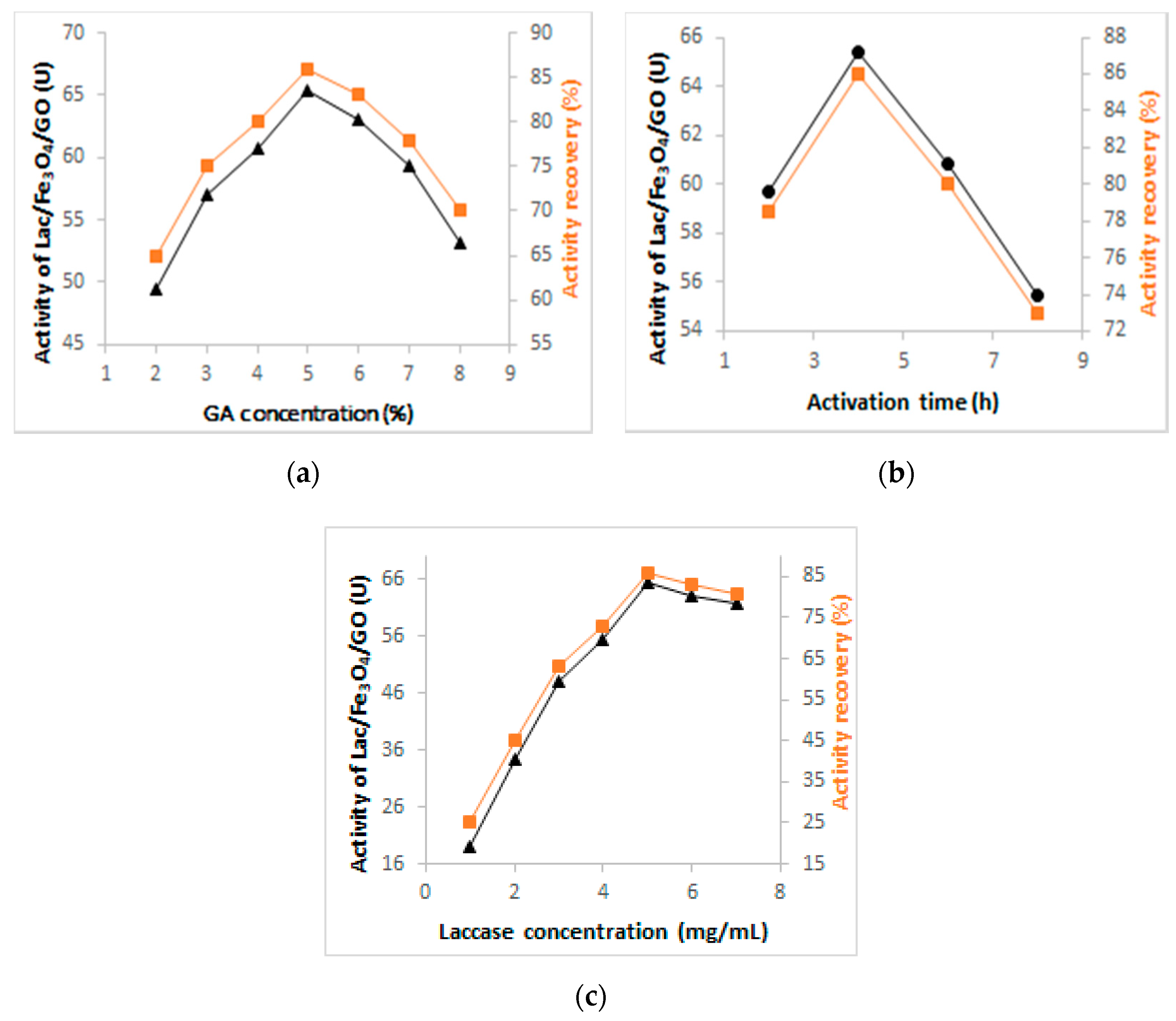
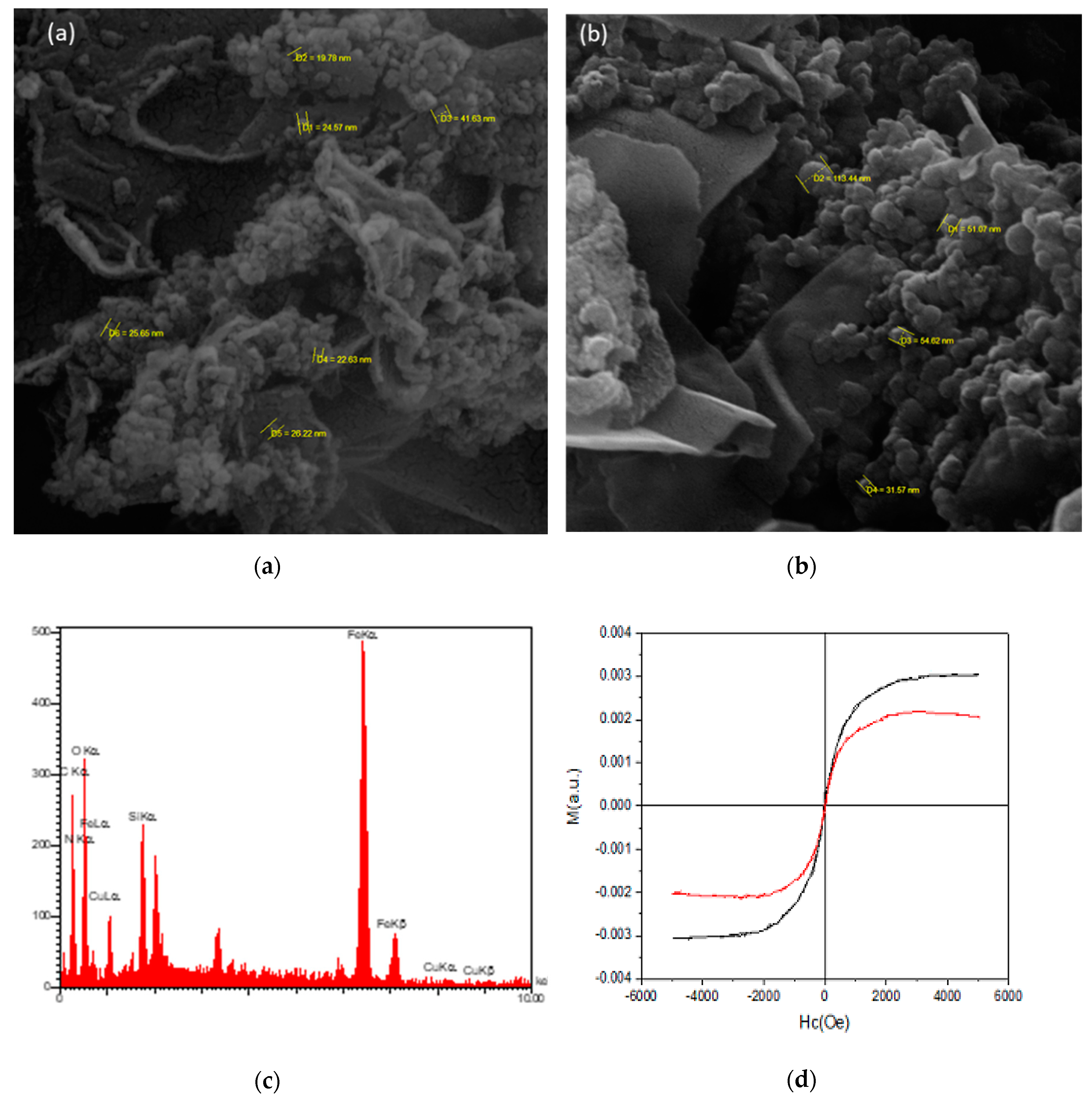


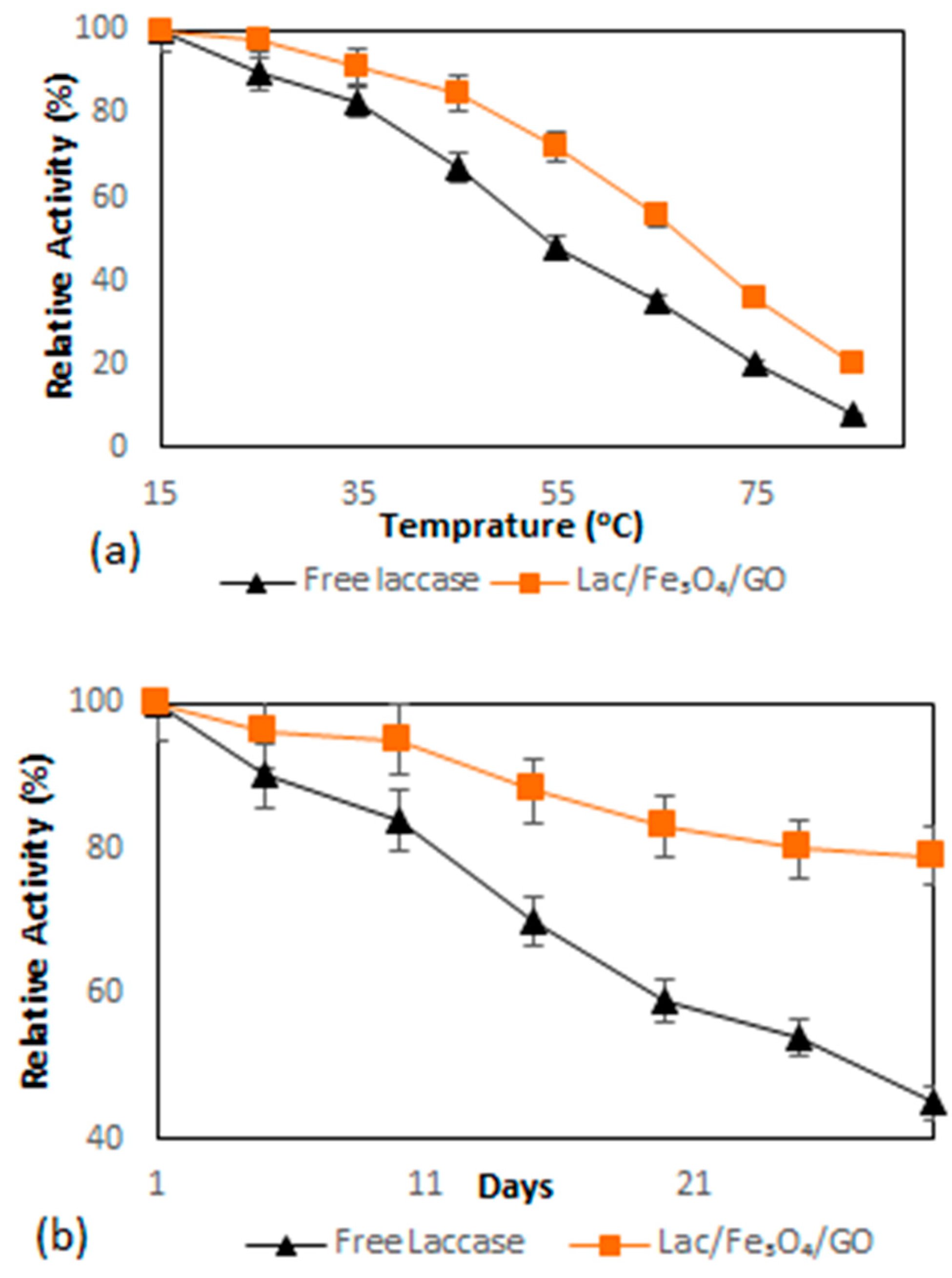
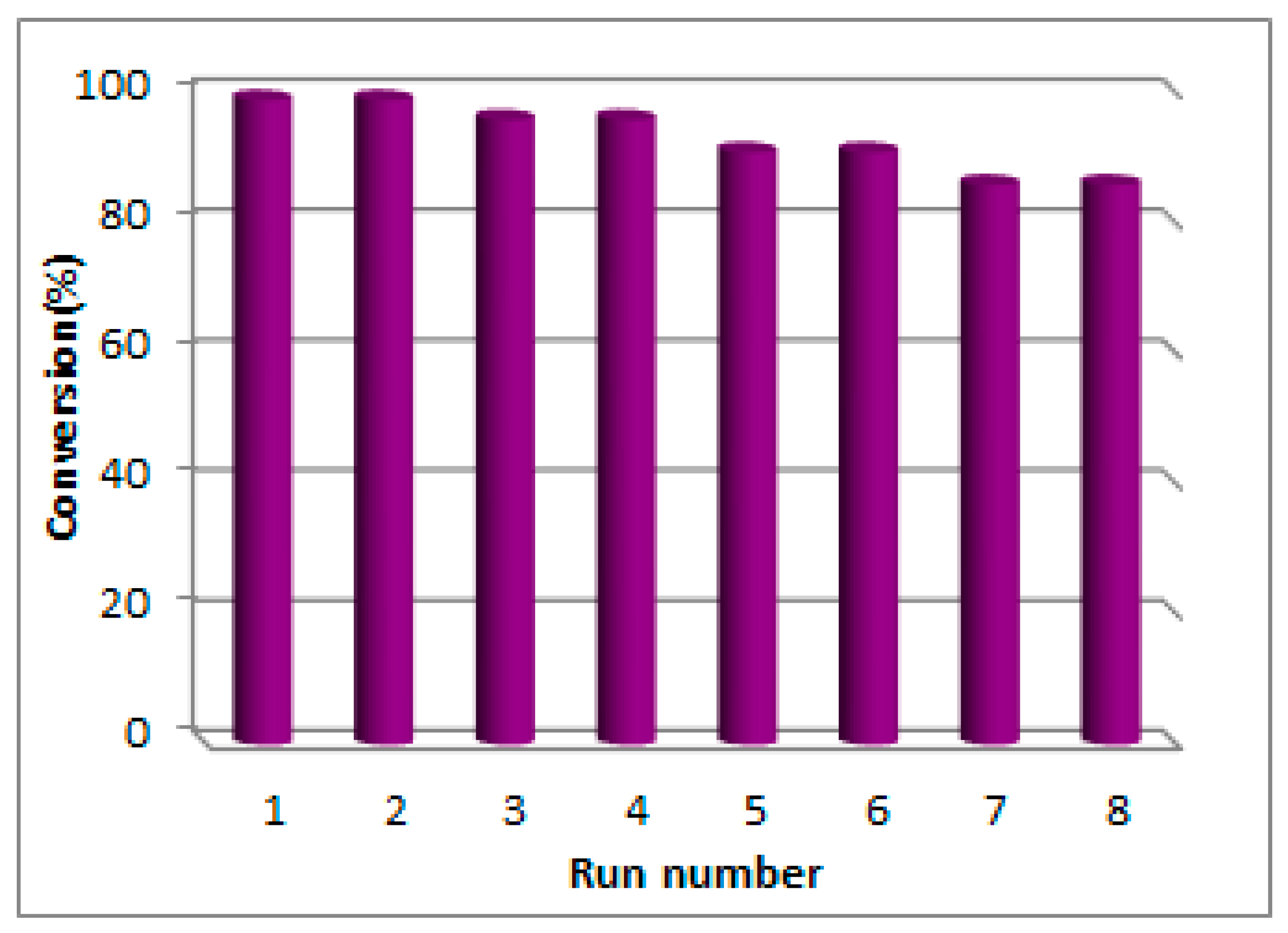
| Entry | Enzyme | Km[mM] | Vmax |
|---|---|---|---|
| 1 | Free Laccase | 0.045 | 2.9 |
| 2 | Lac/Fe3O4/GO | 0.073 | 1.4 |
| Entry | Catalyst (U) | Solvent | GC Yield (%) |
|---|---|---|---|
| 1 | No Lac/Fe3O4/GO | PBS (0.1 M pH = 5) | − |
| 2 | Fe3O4 (50 mg) | PBS (0.1 M pH = 5) | 10 |
| 3 | Lac/Fe3O4/GO (30) | PBS (0.1 M pH = 5) | 34 |
| 4 | Lac/Fe3O4/GO (40) | PBS (0.1 M pH = 5) | 75 |
| 5 | Lac/Fe3O4/GO (50) | PBS (0.1 M pH = 5) | >99 |
| 6 | Lac/Fe3O4/GO (50) | PBS (0.1 M pH = 4) | 80 |
| 7 | Lac/Fe3O4/GO (50) | PBS (0.1 M pH = 6) | 85 |
| 8 | Lac/Fe3O4/GO (50) | PBS (0.1 M pH = 7) | 67 |
| 9 | Lac/Fe3O4/GO (50) | 0.1 M sodium acetate buffer pH = 5 | 70 |
| 10 | Lac/Fe3O4/GO (50) | H2O | 40 |
| 11 | Lac/Fe3O4/GO (50) | EtOH | 53 |
| 12 | Lac/Fe3O4/GO (50) | H2O/EtOH (1:1) | 60 |
| 13 | Lac/Fe3O4/GO (50) | DMSO | − |
| 14 | Lac/Fe3O4/GO (50) | DMF | − |
| Entry | 2,3-dihydrophthalazine-1,4-dione | Sodium Benzenesulfinate | Product | Yield (%) |
|---|---|---|---|---|
| 1 |  |  |  | 81 |
| 2 |  |  |  | 95 |
| 3 |  |  | 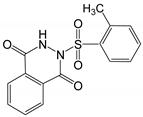 | 90 |
| 4 |  |  |  | 73 |
© 2020 by the authors. Licensee MDPI, Basel, Switzerland. This article is an open access article distributed under the terms and conditions of the Creative Commons Attribution (CC BY) license (http://creativecommons.org/licenses/by/4.0/).
Share and Cite
Rouhani, S.; Azizi, S.; Kibechu, R.W.; Mamba, B.B.; Msagati, T.A.M. Laccase Immobilized Fe3O4-Graphene Oxide Nanobiocatalyst Improves Stability and Immobilization Efficiency in the Green Preparation of Sulfa Drugs. Catalysts 2020, 10, 459. https://doi.org/10.3390/catal10040459
Rouhani S, Azizi S, Kibechu RW, Mamba BB, Msagati TAM. Laccase Immobilized Fe3O4-Graphene Oxide Nanobiocatalyst Improves Stability and Immobilization Efficiency in the Green Preparation of Sulfa Drugs. Catalysts. 2020; 10(4):459. https://doi.org/10.3390/catal10040459
Chicago/Turabian StyleRouhani, Shamila, Shohreh Azizi, Rose W. Kibechu, Bhekie B Mamba, and Titus A. M. Msagati. 2020. "Laccase Immobilized Fe3O4-Graphene Oxide Nanobiocatalyst Improves Stability and Immobilization Efficiency in the Green Preparation of Sulfa Drugs" Catalysts 10, no. 4: 459. https://doi.org/10.3390/catal10040459
APA StyleRouhani, S., Azizi, S., Kibechu, R. W., Mamba, B. B., & Msagati, T. A. M. (2020). Laccase Immobilized Fe3O4-Graphene Oxide Nanobiocatalyst Improves Stability and Immobilization Efficiency in the Green Preparation of Sulfa Drugs. Catalysts, 10(4), 459. https://doi.org/10.3390/catal10040459







